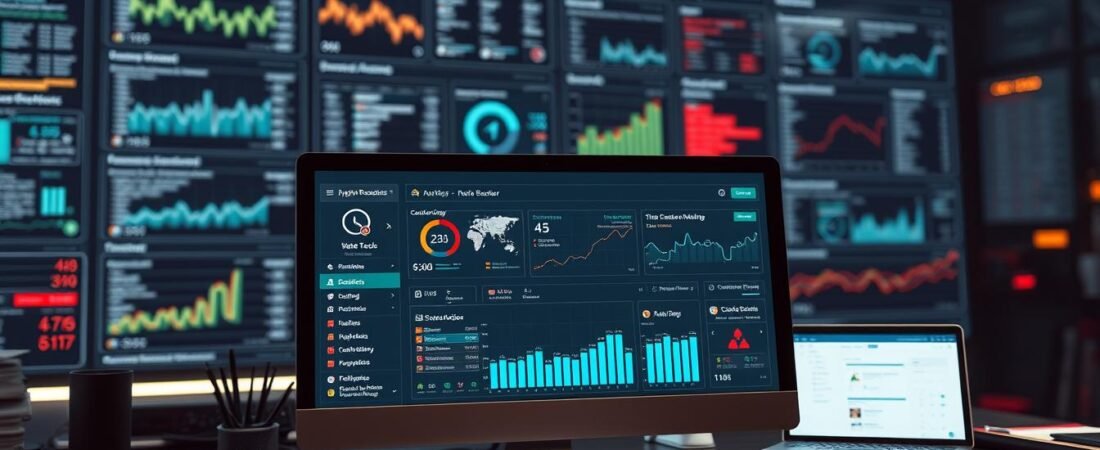AI automation for e-commerce SEO audits. In today’s digital landscape, staying ahead in the competitive world of online business is crucial. With the global e-commerce market projected to reach $6.3 trillion, businesses need to ensure their websites are optimized for search engines. This is where advanced tools come into play, helping you streamline your efforts and improve your rankings.
Consumers increasingly rely on search engines to find products and services. However, competing with major retailers can be challenging, especially with low conversion rates. By leveraging modern solutions, you can automate routine tasks and focus on strategies that drive results.
Combining human expertise with these tools leads to higher-quality audits and better product descriptions. This approach not only saves time but also enhances your website’s performance. In this post, you’ll discover actionable tips and recommendations to elevate your search engine optimization efforts.
Key Takeaways
- Advanced tools can automate routine tasks, saving you time and effort.
- Combining human expertise with technology improves the quality of audits.
- Focus on strategies that enhance your website’s search engine rankings.
- Actionable tips and tool recommendations can streamline your workflow.
- Optimizing your site’s content and performance is key to staying competitive.
Understanding the Role of AI in E-commerce SEO
The digital marketing landscape has transformed significantly over the past decade. What once seemed like a futuristic concept has now become a practical tool for businesses. This evolution has reshaped how companies approach search engine optimization and online visibility.
The Evolution of AI in Digital Marketing
In the early stages, artificial intelligence was primarily used for basic tasks like keyword research and content generation. Over time, it evolved to handle more complex processes, such as analyzing search engine algorithms and improving website performance. For example, Google’s RankBrain uses machine learning to interpret search queries and deliver more relevant results.
Today, businesses integrate these technologies into their workflows to enhance technical SEO and on-page optimization. Chatbots powered by advanced algorithms improve customer engagement and conversion rates. These innovations highlight the competitive advantage of understanding search intent and staying ahead of trends.
Benefits for Your Online Business
Using these advanced solutions offers several benefits. They automate repetitive tasks, saving you time and effort. Faster data analysis provides actionable insights, helping you refine your strategy. Improved algorithms ensure your website ranks higher in search results, driving more traffic to your site.
| Feature | Benefit |
|---|---|
| Task Automation | Saves time and reduces manual effort |
| Data Analysis | Provides actionable insights |
| Improved Algorithms | Enhances website ranking |
Understanding this evolution is essential for leveraging its full potential in your marketing efforts. By combining human expertise with advanced tools, you can create a more effective and efficient workflow.
Setting Up a Secure and Optimized E-commerce Platform
Building a secure and optimized e-commerce platform is essential for long-term success. A well-structured website not only improves your search engine rankings but also builds customer trust. Combining security measures with technical SEO practices ensures your platform performs at its best.
Why Security and Technical SEO Matter
Security and technical SEO are critical for boosting your site’s performance. A secure platform protects sensitive customer data, while technical optimizations enhance your website’s visibility. Together, they create a seamless user experience and drive more traffic to your business.
For example, platforms like Shopify offer built-in security features, including SSL certificates and HTTPS protocols. These measures not only safeguard your site but also improve its search engine rankings. A secure authentication process, such as Descope integration, further enhances your platform’s reliability.
Essential Technical SEO Practices
Implementing technical SEO best practices is key to optimizing your website. Start with responsive design to ensure your site looks great on all devices. Fast page speeds and proper robots.txt configuration also play a crucial role in improving your site’s performance.
Other important practices include creating XML sitemaps and using structured data. These elements help search engines understand your content better, boosting your rankings. Additionally, SEO-friendly URL structures make it easier for users to navigate your site.
| Practice | Benefit |
|---|---|
| Responsive Design | Improves user experience on all devices |
| Fast Page Speeds | Reduces bounce rates and boosts rankings |
| XML Sitemaps | Helps search engines index your site |
| Structured Data | Enhances content visibility in search results |
Common Technical Issues to Avoid
Technical issues like broken links can detrimentally affect your SEO and user trust. Regularly audit your site to identify and fix these problems. Ensuring your site is free of errors not only improves its performance but also builds customer confidence.
By following a step-by-step checklist, you can ensure no key SEO factor is overlooked. This approach helps you create a secure, optimized platform that drives results and supports your long-term goals.
AI automation for e-commerce SEO audits: Integrating Efficiency in Your Workflow
Modern tools are transforming how businesses approach keyword research and content creation. By integrating advanced solutions, you can streamline your workflow and focus on strategies that drive results. This not only saves time but also enhances the quality of your efforts.
Streamlining Keyword Research
Keyword research is a critical part of any SEO strategy. Tools like Simplified and Drift automate this process, reducing manual workload. They analyze search trends and provide actionable insights, helping you target the right audience.
These tools also test multiple keyword variations, ensuring your content ranks higher in search results. By leveraging their algorithms, you can identify high-performing keywords and optimize your pages effectively.
Enhancing Product Descriptions
Engaging product descriptions are essential for driving buyer interest. Advanced tools can generate and test multiple versions of your copy. This ensures your content resonates with different buyer personas, improving engagement and conversion rates.
For example, dynamically adjusting product descriptions based on user behavior can significantly boost relevance. This approach not only saves time but also ensures consistency across your website.
- Automating keyword research reduces manual effort and improves accuracy.
- Testing multiple product descriptions ensures higher engagement with buyers.
- Dynamic adjustments enhance relevance and improve conversion rates.
- Streamlined workflows lead to faster, more accurate audits.
- Data-driven decisions support long-term success in digital marketing.
By integrating these tools into your workflow, you can achieve a more efficient and effective SEO strategy. This approach not only saves time but also ensures your website performs at its best.
Utilizing AI-Powered Tools for Comprehensive SEO Audits
Selecting the right tools for your website’s performance can make a significant difference in your online presence. With so many options available, it’s essential to choose a solution that aligns with your goals and enhances your strategy.

Choosing the Right AI Tool for Your Needs
When selecting a tool, focus on features like data accuracy, ease of use, and scalability. For example, Outrank offers deep technical audits, while Frase excels in content optimization. Alli AI provides a balance of both, making it a versatile choice for businesses of all sizes.
Consider your specific needs, such as improving ranking or increasing traffic. A tool that offers detailed analytics and actionable insights can help you refine your approach and achieve better results.
Balancing Automation with Human Insight
While automation streamlines repetitive tasks, human insight adds nuance to your strategy. Tools can analyze data and identify trends, but your team’s expertise ensures the findings align with your brand’s voice and goals.
For instance, automated content generation can save time, but a human touch ensures it resonates with your audience. Striking this balance is key to maximizing the impact of your efforts.
| Tool | Key Feature |
|---|---|
| Outrank | Technical audits |
| Frase | Content optimization |
| Alli AI | Versatile solutions |
By testing different tools and refining your selection, you can find the perfect fit for your website. This approach not only boosts efficiency but also supports sustained performance in the long run.
Tailoring Content to Match Buyer Personas and SEO Trends
Personalized content is no longer a luxury but a necessity for modern businesses. By aligning your messaging with buyer personas and current trends, you can create a more engaging and effective strategy. This approach not only improves user experience but also boosts your website’s performance.
Creating Personalized Product Descriptions
Understanding your audience’s needs is the foundation of effective content creation. Advanced tools analyze buyer behavior to suggest language that resonates with different segments. This ensures your product descriptions are relevant and compelling.
For example, a tool might identify that younger audiences prefer casual, conversational tones, while professionals favor concise, technical descriptions. Tailoring your content this way enhances engagement and drives conversions.
“Personalization is not just about addressing the user by name. It’s about understanding their journey and crafting content that speaks directly to their needs.”
Benefits of Tailored Content
Customized messaging improves product relevance and user satisfaction. When your audience feels understood, they are more likely to engage with your brand. This leads to higher conversion rates and increased customer loyalty.
Additionally, staying updated with trends ensures your content remains fresh and competitive. Tools that detect emerging keywords and search patterns help you stay ahead in the digital landscape.
| Strategy | Impact |
|---|---|
| Personalized Descriptions | Boosts engagement and conversions |
| Trend Detection | Ensures content stays relevant |
| Audience Segmentation | Improves messaging accuracy |
Actionable Tips for Customized Messaging
- Use advanced tools to analyze buyer behavior and preferences.
- Segment your audience based on demographics, interests, and buying habits.
- Incorporate trending keywords naturally into your content.
- Test different messaging styles to see what resonates best.
- Regularly update your approach based on performance data.
By focusing on personalization and trend awareness, you can create content that truly connects with your audience. This not only enhances your website’s performance but also ensures long-term success in a competitive market.
Leveraging A/B Testing to Optimize Your SEO Strategy
A/B testing is a powerful method to refine your online strategy and boost performance. By comparing two versions of a webpage or content, you can identify what resonates best with your audience. This approach helps you make data-driven decisions that enhance your search engine rankings and improve user engagement.

Running Effective Testing Experiments
To get started, define clear goals for your A/B tests. Whether it’s improving conversion rates or increasing traffic, having a specific objective ensures meaningful results. Use tools like Google Optimize or Optimizely to set up experiments easily.
Test different elements such as headlines, product descriptions, or call-to-action buttons. For example, a case study showed that changing a single word in a product description increased sales by 12%. This highlights the impact of small tweaks on overall performance.
Modern solutions can speed up the testing process by generating multiple iterations quickly. They analyze user behavior and provide actionable insights, helping you refine your strategy in real-time. This not only saves time but also ensures your content remains relevant.
“Continuous testing is the key to staying ahead in the ever-changing digital landscape. It allows you to adapt quickly and maintain a competitive edge.”
Monitoring key performance indicators (KPIs) is crucial for success. Track metrics like click-through rates, bounce rates, and conversion rates to measure the effectiveness of your tests. Adjust your approach based on the data to achieve better results.
- Define clear goals for your A/B tests to ensure meaningful outcomes.
- Test different elements like headlines, descriptions, and CTAs.
- Use advanced tools to speed up the testing process and gain insights.
- Monitor KPIs to measure performance and refine your strategy.
- Continuously test and adapt to stay ahead in the digital landscape.
By integrating A/B testing into your workflow, you can create a more effective and efficient SEO strategy. This approach not only improves your website’s performance but also ensures long-term success in a competitive market.
Data and Analytics: Driving Informed SEO Decisions with AI
Data-driven decisions are reshaping how businesses approach online visibility and performance. By leveraging analytics, you can uncover hidden trends and refine your strategy for better results. This approach ensures your website stays competitive in a constantly evolving digital landscape.
Interpreting Key SEO Metrics
Monitoring the right metrics is essential for understanding your website’s performance. Focus on factors like page speed, bounce rate, and ranking fluctuations. These indicators provide actionable insights into how users interact with your site.
For example, a faster page load time can reduce bounce rates and improve traffic. Tools like Google Analytics make it easy to track these metrics and identify areas for improvement. Regularly reviewing this data helps you stay ahead of the curve.
| Metric | Impact |
|---|---|
| Page Speed | Improves user experience and reduces bounce rates |
| Bounce Rate | Indicates content relevance and engagement |
| Ranking Fluctuations | Highlights changes in search engine visibility |
Preparing for Future Trends
Predictive analytics and machine learning are transforming how businesses approach SEO. These technologies analyze large data sets to forecast trends and optimize strategies. By staying updated, you can adapt to changes in search engine algorithms and user behavior.
For instance, tools that detect emerging keywords help you create content that resonates with your audience. This proactive approach ensures your website remains relevant and competitive.
“The future of SEO lies in understanding data and using it to anticipate user needs. This approach not only improves rankings but also enhances the overall user experience.”
Integrating analytics tools with your existing platforms provides a holistic view of your website’s performance. This ensures you make informed decisions that drive long-term success.
Conclusion
Optimizing your website’s performance is key to staying competitive in today’s digital world. By leveraging advanced tools, you can streamline your workflow and focus on strategies that drive meaningful results. From technical improvements to personalized content, these solutions enhance your site’s quality and user experience.
Balancing technology with human insight ensures your strategy remains effective and aligned with your brand’s goals. Continuous optimization and data-driven decisions help you adapt to changing trends and maintain a strong online presence.
Take the first step today. Experiment with the tools and techniques discussed to improve your website’s ranking and overall performance. Your efforts will not only boost visibility but also support long-term growth for your business.
